The Russian nation has designed and used various flags throughout history. Listed in this article are flags — federal, administrative, military, etc. — used between the time of the Tsardom of Russia (1547–1721), Russian Empire (1721–1917) and today's Russian Federation (1991–present). Also included are flags from the Soviet Union (1922–1991), a country that existed as a federal union of 15 distinct national republics, including the Russian SFSR (1917–1991).
Flags of the Russian Federation
State flag
| Flag | Date | Use | Description |
|---|---|---|---|
.svg.png.webp) | 1991–1993 | Flag of the Russian Federation from 12 December 1991 to 11 December 1993. Previously used by anti-GKChP protesters during the 1991 August Coup and then as flag of the Russian SFSR during the final days of the USSR. Still included in the State Heraldic Register. | |
 | 1993–present | Proportion changed from 1:2 to 2:3. First, the Decree of the President of the Russian Federation "On the State Flag of the Russian Federation", adopted on December 11, 1993, then Constitutional law "On the State Flag of the Russian Federation" adopted on 25 December 2000. |
Presidential flags
| Standard | Date | Use | Description |
|---|---|---|---|
 | 1994–present | Presidential Standard | Current Presidential Standard of the Russian Federation. |
 | 1994–present | Flag of the President as the Commander-in-Chief of the Armed Forces |
Military flags
Following the collapse of the Soviet Union in 1991, for a brief time, many Soviet era flags were still in use until new designs replaced them in the early 2000s. The new flags of the Russian Armed Forces are heavily inspired by the regimental banners and flags of the late Imperial Russian Army and Navy.
Flags of service branches
| Flag | Date | Use | Description |
|---|---|---|---|
 | 2003–present | Flag of the Ministry of Defence | |
 | 2004–present | Flag of the Ground Forces | |
 | 2000–present | Flag of the Navy | In 1992, the ensign of the Imperial Russian Navy was revived and replaced the Soviet era Naval Flag, however the new design used a lighter shade of blue, rather than the traditional dark blue. On December 29, 2000, the flag was changed to its original historical appearance with dark blue. |
 | 2015–present | Flag of the Aerospace Forces | |
 | 2004–present | Flag of the Airborne Forces | A bicolour of horizontal stripes, blue and green defaced with the Russian Airborne Forces emblem. |
 | 2004–present | Flag of the Strategic Missile Forces |
Flags of the Ground Forces
Flags of the arms of the Ground Forces of the Russian Federation
| Flag | Date | Use | Description |
|---|---|---|---|
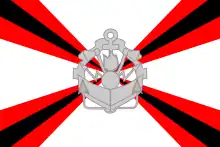 | 2005– | Flag of the Engineer Troops | |
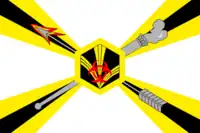 | 2005– | Flag of the Nuclear, Biological and Chemical Protection Troops | |
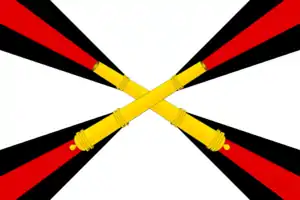 | 2006– | Flag of the Missile Troops and Artillery | |
 | 2007– | Flag of the Air Defence Troops of the Ground Forces | Not to be confused with the Air Defence Troops of the Aerospace Forces. |
 | 2007– | Flag of the Communication Troops | |
 | 2005– | Flag of the Main Directorate of the General Staff | |
 | 2007– | Flag of the Electronic Warfare Troops | |
 | 2007– | Flag of the Railway Troops | |
 | ?– | Flag of the Special Operations Forces |
Flags of the Aerospace Forces
The Aerospace Forces are a branch of the Armed Forces of the Russian Federation, it has three arms, the Russian Air Force, the Air Defense Forces, and the Russian Space Forces. The Air Defense Forces does not have a flag.
| Flag | Date | Use | Description |
|---|---|---|---|
 | 2004– | Flag of the Air Force | |
 | 2015– | Flag of the Space Forces | Light blue field with the Russian Space Forces emblem (Space Forces Circumflex). |
Flags of the Rear of the Armed Forces
| Flag | Date | Use | Description |
|---|---|---|---|
 | 2004–2009 | Flag of the Rear of the Armed Forces |
Military district flags
| Flag | Date | Use | Description |
|---|---|---|---|
 | 2016– | Flag of Western Military District | |
 | 2016– | Flag of Southern Military District | |
 | 2016– | Flag of Central Military District | |
 | 2016– | Flag of Eastern Military District |
Banners of the Armed Forces
Each branch of the Armed Forces has a representative banner, one for the Ground Forces, the Aerospace Forces, the Navy, and one to represent the entire Armed Forces as a whole.
| Obverse (Front) | Reverse (Back) | Date | Use | Description |
|---|---|---|---|---|
.svg.png.webp) | .svg.png.webp) | 2000–2003 | Banner of the Armed Forces | The first banner of the Armed Forces of the Russian Federation was introduced on 8 December 2000, later confirmed by Federation Council on 20 December and signed by Vladimir Putin on 29 December. It was a plain red field, it symbolized the traditional red color of the Armed Forces of the Soviet Union. |
.svg.png.webp) | .svg.png.webp) | 2003– | The present banner of the Armed Forces of Russian Federation is introduced under a resolution by State Duma in June 2003. This banner consists of two double-headed eagles, on the obverse side is the coat of arms of the Russian Federation, and on the reverse side is the middle emblem of the armed forces of the Russian Federation. The banner follows the principles and format of historically older Russian military flags that were last used prior to the Russian Revolution in 1917. It also contains four stars in each corner of the banner to symbolize the heritage of the Soviet Armed Forces. The reverse side also contains two pieces of text written in old style Slavic typeface, the top side of the banner contains the inscription "Fatherland" ("Отечество") and on the bottom side the inscription reads "Duty [and] Honor" ("Долг Честь").[1] | |
.svg.png.webp) | .svg.png.webp) | 2002– | Banner of the Ground Forces | The banner of the Russian Ground Forces was introduced by decree No. 141 on February 4, 2002, by Vladimir Putin. It is similar to the above banner, but doesn't have stars and inscriptions, on the reverse side is the middle emblem of the Russian Ground Forces. |
 |  | 2002– | Banner of the Air Force/Aerospace Forces | The banner of the Russian Air Forces was introduced by decree No. 141 on February 4, 2002, by Vladimir Putin.[2] It became the banner of the newly created Aerospace Forces branch, which saw the merger between the Russian Air Forces and the Air Defence Forces on August 1, 2015. |
 |  | 2000– | Banner of the Navy | The ensign of the Russian Navy is used as the banner of the Russian Navy. On December 29, 2000, Russian President Vladimir Putin signed a federal law making the naval ensign of the Russian navy the official banner of the Russian Navy.[3] |
Victory Banner
The Victory Banner was a historical banner raised atop of the Reichstag building in Berlin, by the Red Army, on May 1, 1945. It signified the victory over Nazi Germany, and served as the main symbol of victory of the Soviet people. It was amended in Russian law in 1996, but with a new design to distance the new Russian state from any usage of Communist iconography. In 2007, following pressure from Red Army veterans, the original Victory Banner design replaced the 1996 variant, and has since then served its usage in virtually every single Victory Day parade held across Russia.
| Banner | Date | Use | Description |
|---|---|---|---|
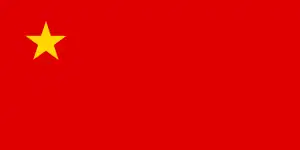 | 1996–2007 | The Symbol of Victory Banner was an alternative to using the historic Victory Banner, which contained the hammer and sickle. | |
 | 2007– | The Banner of Victory raised on the Reichstag in 1945. Replicas of the Victory Banner can be used alongside the national flag on Victory Day. |
Command Standards
| Standard | Date | Use | Description |
|---|---|---|---|
 | 2003– | Standard of the Minister of Defence | |
 | ?– | Standard of the Chief of the General Staff | |
 | ?– | Standard of the Commander-in-Chief of the Ground Forces | |
 | ?– | Standard of the Commander-in-Chief of the Navy | |
 | 2015– | Standard of the Commander-in-Chief of the Aerospace Forces | |
 | ?– | Standard of the Commander of the Air Force – Deputy Commander-in-Chief of the Aerospace Forces | |
 | ?– | Standard of the Commander of the Strategic Missile Forces | |
 | ?– | Standard of the Commander of the Space Forces | |
 | ?– | Standard of the Commander of the Airborne Forces |
Paramilitary flags
This section covers flags of the various government paramilitary organizations which are not part of the Russian military, but are structured similarly by ranking system, uniforms, and are equipped with both light and heavy arms
Flags of non-military security forces
| Flag | Date | Use | Description |
|---|---|---|---|
 | 1992– | Flag of the Ministry of Emergency Situations | |
.svg.png.webp) | 1992– | Departmental flag of the Ministry of Emergency Situations | |
 | 2003– | Flag of the Border Service of the Federal Security Service | |
 | 2005– | Flag of the Federal Service of Military-Technical Cooperation | |
 | 2008– | Ensign of the Coast Guard | A blue and white Saltire on a light green background. |
 | 1994– | Flag of the Federal Customs Service | A white Saltire on a dark green background. |
 | 2001– | Flag of the Courier Service | |
 | 2005– | Flag of Federal Penitentiary Service | |
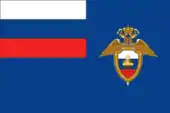 | ?– | Flag of the Main Directorate of Special Programs of the President | |
 | 2008– | Flag of the Office of the Prosecutor General | |
 | ?– | Flag of the Investigative Committee | |
 | 2006– | Flag of Federal Service of Bailiffs | |
.svg.png.webp) | ?– | Flag of the Ministry of Internal Affairs | |
 | ?– | ||
 | 2007–2016 | Flag of Federal Migration Service | |
 | 2000–2016 | Flag of the Federal Service for Special Construction | |
 | ?– | Flag of the Main Directorate for Traffic Safety |
Flags of special services
| Flag | Date | Use | Description |
|---|---|---|---|
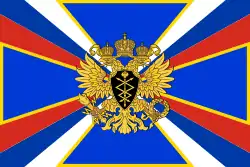 | 2001–2003 | Flag of Federal Agency of the Governmental Communication and the Information at the President | |
 | 2002– | Flag of the Federal Protective Service | |
 | 2010– | Flag of the Federal Security Service | |
 | 2008– | Flag of Director of the Federal Security Service | |
.svg.png.webp) | 2009– | Flag of Foreign Intelligence Service | |
 | 2015–2016 | Flag of the Internal Troops | |
 | 2016– | Flag of National Guard Forces Command | |
 | 2016– | Flag of the National Guard | |
Pennants
| Flag | Date | Use | Description |
|---|---|---|---|
| 2011– | Pennant of the Ministry of Health | ||
 | 2009– | Pennant of the Federal Agency for Fishery | |
 | 2009– | Pennant of the Chief of the Federal Agency for Fishery |
Historical flags of Russia
Civil ensign and national flag
Prior to the creation of the first official flag of Russia in 1858, several merchant flags were used to represent Russia, the most notable being the White, Blue, and Red tricolour devised by Tsar Peter the Great. The historical State Flags of Russia were signed by decree to officially represent the country as a whole. The Black, Yellow, and White tricolour became the first official flag of Russia in 1858, with previous flags being de facto unofficial flags of Russia.
| Flag | Date | Use | Description |
|---|---|---|---|
.svg.png.webp) | 1668–1693 | Civil ensign of the Tsardom of Russia | Ensign of the Oryol ship. |
 | 1696–1721 | Peter the Great's tricolour was the merchant flag of the Russian Empire. However, the flags used by the Russian Army were regimental flags with the Double-Headed Eagle, the official Imperial symbol, in the centre. The Imperial Standard was the black Double-Headed Eagle displayed on a golden banner, which represented the Empire and the Emperor, the absolute ruler of Russia.[4] When the black-yellow-white flag was in use between 1858 and 1896, the white-blue-red flag was still used as a merchant ensign.[4] | |
| 1721–1896 | Civil ensign of the Russian Empire | ||
.svg.png.webp) | 1858–1896 | State flag of the Russian Empire | On 11 June 1858, by decree of Alexander II, the heraldic colors of the empire were approved for flags, banners and other items (draperies, rosettes, etc.). It became the first State flag of Russia in 1865. The white-blue-red flag was reintroduced in 1883 but the black-yellow-white remained in use until it was fully replaced in all circumstances in 1896.[5][6][7][8][9] |
 | 1896–1917 | On 28 April 1883, Alexander III amended the 1858 decree "on flags for decorating buildings on solemn occasions" to be replaced exclusively with the white-blue-red colours. This meant that the white-blue-red flag was now to be used on land in addition to at seas. It fully replaced the black-yellow-white flag when it became the only official National flag in time for the coronation of Nicholas II in 1896. | |
| 1917–1918 | National flag of the Russian Republic | The Russian Provisional Government and the Russian Republic kept using the same flag after the monarchy was overthrown in the February Revolution. During the Russian Civil War, it was also used by the Russian State in 1918–1920 and the White Guards overall until their defeat in 1923. | |
| 1918–1920 | National flag of the Russian State | ||
.svg.png.webp) | 1918–1937 | State flag of the Russian SFSR | The first flag of the RSFSR was established by decree on 13 April 1918. However the law never provided an official drawing or depiction. Instead, a simple red flag was commonly used. The description of the decree stated that the "flag of the Russian Republic is set on a red banner with the inscription: Russian Socialist Federative Soviet Republic (Russian: Российская Советская Федеративная Социалистическая Республика)." The decree however did not specify the exact shade of red used on the flag, nor the exact placement and size of the inscription, the ratio of the flag itself and the colour and font of the words. There is no evidence to suggest such a flag was ever produced and used. Later that year, on 17 June 1918, a decree was established on the new state flag of the RSFSR. This time, the law provided an official image for the flag. The ratio of the flag was 1:2, located in the upper left corner, the letters "R.S.F.S.R" appeared in old Slavonic font and were surrounded by a golden border. |
.svg.png.webp) | 1937–1954 | Red banner with stylized "RSFSR" abbreviation in gold Cyrillic letters in the honour canton. | |
.svg.png.webp) | 1954–1991 | The flag of the Soviet Union with a blue band at the hoist. | |
.svg.png.webp) | 1991–1993 | Flag of the Russian SFSR from 1 November 1991 (de facto from 22 August 1991, after the August Coup) to 11 December 1993. |
Flag of the Soviet Union
| Flag | Date | Use | Description |
|---|---|---|---|
.svg.png.webp) | 1922–1923 | State flag of the Soviet Union | The first flag of the Soviet Union is a red flag with the state emblem in the center and fimbriated in white. |
.svg.png.webp) | 1923–1924 | The second flag of the Soviet Union with the golden fimbriated canton, adopted shortly after the end of the Russian Civil War. | |
.svg.png.webp) | 1924–1936 | The third flag of the Soviet Union. | |
.svg.png.webp) | 1936–1955 | The fourth flag of the Soviet Union, this design was prominently used during the Second World War. | |
 | 1955–1991 | The fifth and final flag of the Soviet Union. |
Personal flags
Monarch' flags
| Standard | Date | Use | Description |
|---|---|---|---|
.png.webp) | c. 1462 | Flag of the Grand Prince of Moscow | Adopted under Ivan III the Great. |
.svg.png.webp) | 1693–1703 | Flag of the Tsar of Russia | Adopted under the rule of Peter the Great.[10][11] |
| 1703–1742 | Imperial Standard | ||
 | 1742–1799; 1801–1828 | Russian Imperial Standard used at palaces.[10] | |
 | 1799–1801 | Russian Imperial Standard introduced by Paul I. This flag is depicted on many documents of that era.[12] | |
 | c. 1835 | In the album of flags of 1835, an Imperial Standard used at palaces was reported.[10] | |
.svg.png.webp) | 1858–1917 | Standard of the Emperor of Russia on land, adopted in 1858.[10][11] |
Other Royal flags
| Standard | Date | Use | Description |
|---|---|---|---|
.svg.png.webp) | c. 1848 | Standard of the Empress of Russia | |
 | ?–1917 | ||
 | ?–1917 | Standard of the Tsesarevich of Russia | |
 | ?–1917 | Standard of the Empress Princes of Russia | |
 | ?–1917 | Standard of the Grand Duke of Russia | |
 | ?–1917 | Standard of the Grand Duchess of Russia | |
 | ?–1917 | Ensign of the Tsesarevich of Russia | |
 | ?–1917 | Ensign of the Grand Duke of Russia | |
 | 1862–1870 | Flag of the Grand Duke of the Caucasus | |
 | 1870–1917 |
Flag of the Supreme Ruler
| Standard | Date | Use | Description |
|---|---|---|---|
 | 1919–1920 | Flag of the Supreme Ruler of the Russian State | Used by Admiral Alexander Kolchak during the Russian Civil War. |
Presidential standard
| Standard | Date | Use | Description |
|---|---|---|---|
.svg.png.webp) | 1991 | Presidential standard of the Russian SFSR | Unofficial standard of the president of the Russian Soviet Federative Socialist Republic, used during the inauguration of Boris Yeltsin on 10 July 1991.[13][14] A law establishing the official standard for the President of Russia was not created until 1994, at the time of Yeltsin's first inauguration, an impromptu standard was created solely for the event, but without any official decree or design. |
Banners
| Banner | Date | Use | Description |
|---|---|---|---|
.svg.png.webp) |
c. 1385 | Banner of the Novgorod Republic | Banner used by the Novgorod Republic, depicting a white castle on a red field. |
 |
1552 | Banner of the Most Merciful Savior | Banner used by Ivan IV during the Siege of Kazan. |
 |
1610s | Banner of Dmitry Pozharsky | Battle banner of the Second Volunteer Army depicting appearance of Archangel Michael to Joshua. |
 | 1696 | Armorial Banner of Peter the Great | The armorial banner of Peter the Great was created in 1696. Made from red taffeta with a white border, the banner depicted a golden eagle hovering over the sea. On the chest of the eagle in the circle is the Savior, next to the Holy Spirit and the holy apostles Peter and Paul. The banner was likely made for the second Azov campaign. |
Historical pennants
| Flag | Date | Use | Description |
|---|---|---|---|
.png.webp) |
?–1697 | Masthead pennant of the Tsardom of Russia | |
 | c. 1881 | Pennant of the Ministry of Railways | |
 |
?–1917 | Pennant of the Emperor of Russia | |
 | ?–1917 | Pennant of the Empress of Russia | |
 |
?–1917 | Pennant of the Tsesarevich of Russia | |
 | ?–1917 | Pennant of the Tsesarevna of Russia | |
 |
?–1917 | Pennant of the Grand Duke of Russia | |
 | ?–1917 | Pennant of the Grand Duchess of Russia | |
 | ?–1917 | Pennant of the Admiral General of Royal blood | |
 | 1919–1920 | Pennant of the Supreme Ruler of the Russian State |
Proposed flags
| Flag | Submitted | Planned use | Description |
|---|---|---|---|
.svg.png.webp) _common.svg.png.webp) .svg.png.webp) | 1914 | National flag of the Russian Empire | A tricolour of horizontal stripes, white, blue and red, with a yellow canton with the coat of arms. Introduced as a flag for private use on the outbreak of World War I on 8 September 1914 with introduction as a national flag planned for after the war, hence never officially adopted.[15] |
.svg.png.webp) | 1948, 1949 | State flag of the Russian SFSR | A proposal for the state flag of the RSFSR was created by artist Alexey Kokorekin. It added white and blue horizontal stripes at the bottom, both two stripes took 1⁄6 of the flag's height. |
.svg.png.webp) | c. 1949 | State flag of the Russian SFSR | Another proposal with the traditional Russian tricolour at the bottom. |
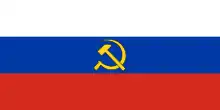 | c. 1950 | State flag of the Russian SFSR | Another proposal for the state flag of the RSFSR was created by Mikhail Rodionov. It consisted of a traditional tricolour flag and a hammer and a sickle in the middle of the flag. Because of his proposal, he was accused of anti-Sovietism in 1950, at the Leningrad affair case.[16] |
.svg.png.webp) .svg.png.webp) | 1994; 1997 | State flag of the Russian Federation | Project flags of Russia after the dissolution of the USSR with communist symbols slightly modified, submitted multiple times in the State Duma by Communist and Agrarian deputies.[17][18][19] |
.svg.png.webp) | 2007 | As described in a bill from 2007 vetoed by Vladimir Putin's presidential decree.[20] The flag was used on public display during celebrations of the Victory Day and other events related to past wars during the first decade of the 2000s, along with the state flag. | |
.svg.png.webp) | 2011 | State flag of the Russian Federation | On April 18, Vladimir Zhirinovsky with the LDPR party proposed to the State Duma the adoption of the Russian Imperial (Romanov's) flag as the official flag of Russia.[21] |
 | 2022 | State flag of the Russian Federation | On April 19, the CPRF proposed to the State Duma the adoption of the Soviet flag as the official flag of Russia.[22] |
Flags of Russian cities
| Flag | Date | Use | Description |
|---|---|---|---|
.png.webp) | 2003– | Flag of Abakan | Two red and blue horizontal stripes and a white background with the emblem to the hoist. |
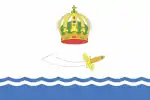 | 1997– | Flag of Astrakhan | A crown above sword on a white background with a blue wave pattern at the bottom. |
 | 1999– | Flag of Belgorod | Two horizontal stripes: top - blue and bottom - white. In the roof there is an image of the figures of the coat of arms of the city. |
 | 1995– | Flag of Barnaul | The arms of the city of Barnaul on a blue background. |
 | 2002– | Flag of Chelyabinsk | A camel in front of a wall on a green and yellow background. |
.svg.png.webp) | 2002– | Flag of Cherepovets | A blue pall on a golden background. |
.svg.png.webp) | 1996– | Flag of Irkutsk | |
 | 2003– | Flag of Ivanovo | A woman using a spindle on an all blue background. |
.svg.png.webp) | 2000– | Flag of Izhevsk | |
 | 1996– | Flag of Kaliningrad | A coat of arms in front of a ship on an all blue background. |
 | 2000– | Flag of Kaluga | |
 | 2004– | Flag of Kazan | A dragon walking on a mostly white background with a thin green line at the bottom. |
.svg.png.webp) | 2010– | Flag of Kirov | A hand holding a bow beneath a cross on an all yellow background. |
 | 2006– | Flag of Krasnodar | |
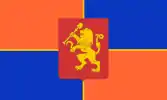 | 1995– | Flag of Krasnoyarsk | |
 | 2000– | Flag of Kursk | |
.svg.png.webp) | 2004– | Flag of Magnitogorsk | A black triangle on a silver‐colored background. |
 | 1995– | Flag of Moscow | Saint George with a lance riding on a silver horse stabbing a zilant on a dark red background. |
 | 2006– | Flag of Nizhny Novgorod | A bright red deer on a white-colored background. |
.png.webp) | 2006– | Flag of Nizhny Tagil | The coat of arm of Nizhny Tagil on a Maroon Background. |
 | ?– | Flag of Norilsk | A polar bear holding a key on a vertically divided blue and red background. |
 | 2018– | Flag of Novokuznetsk | |
 | 2018– | Flag of Novosibirsk | |
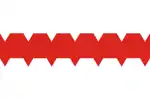 | 2014– | Flag of Omsk | |
 | 2012– | Flag of Orenburg | |
 | 1998– | Flag of Oryol | |
.svg.png.webp) | 2003– | Flag of Ozyorsk, Chelyabinsk Oblast | |
 | ?– | Flag of Perm | A bear carrying a book beneath a cross on an all red background. |
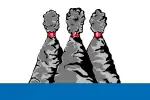 | 2015– | Flag of Petropavlovsk-Kamchatsky | |
.svg.png.webp) | 2001– | Flag of Petrozavodsk | |
.svg.png.webp) | 2010– | Flag of Pskov | |
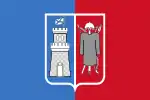 | 1998– | Flag of Rostov-on-Don | |
.png.webp) | 2001– | Flag of Ryazan | A crown sitting above and to the left of a man holding a sword on an all yellow background. |
 | 1992– | Flag of Saint Petersburg | An anchor and a hook crossing each other with a scepter in the intersection of the two, all on a red background. |
.svg.png.webp) | 1998– | Flag of Salekhard | |
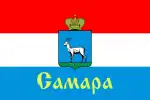 | 2015– | Flag of Samara | A coat of arms above the name of the city in front of a horizontally divided red white and blue background. |
 | 1997– | Flag of Saratov | A coat of arms in front of a horizontally divided blue and white background. |
.png.webp) | 2006– | Flag of Sergiyev Posad | The walls of a city with two axes floating above it on a blue background. |
.svg.png.webp) | 2006– | Flag of Sochi | |
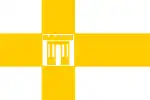 | 2014– | Flag of Stavropol | |
.png.webp) | 2004– | Flag of Suzdal | A bird wearing a crown on a horizontally divided blue and red background. |
 | 2005–[23] | Flag of Tolyatti | |
 | 2019– | Flag of Tomsk | A rearing horse on a dark green background. |
 | 2001– | Flag of Tula | |
 | 1999– | Flag of Tver | |
 | 2007– | Flag of Ufa | |
.png.webp) | 2005– | Flag of Ulan-Ude | |
 | 2003– | Flag of Ulyanovsk | A vertical triband of blue, white, and blue, with a golden crown in the middle of the white stripe. |
 | 2010– | Flag of Veliky Novgorod | |
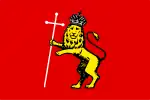 | 1996– | Flag of Vladimir | A lion holding a cross and wearing a crown on an all red background. |
 | 2016– | Flag of Vladivostok | A Coat of arms in front of a blue Saltire on a red background. |
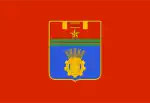 | 1999– | Flag of Volgograd | The arms of the city of Volgograd on a red background. |
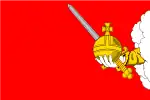 | 2003– | Flag of Vologda | God reaching out from the clouds holding a sword and cruciger on a red background. |
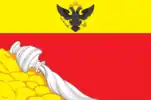 | 2008– | Flag of Voronezh | |
 | 1996– | Flag of Yakutsk | |
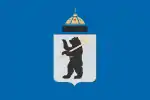 | 1996– | Flag of Yaroslavl | The arms of the city of Yaroslavl on a blue background. |
.svg.png.webp) | 2008– | Flag of Yekaterinburg | A furnace and well on a horizontally divided green, yellow and blue background. |
 | ?- | Flag of Zlatoust | A yellow pegasus above a yellow stripe. |
See also
References
- ↑ "Флаги России-VEXILLOGRAPHIA". www.vexillographia.ru.
- ↑ "Указ Президента Российской Федерации от 04.02.2002 № 141". sbornik-zakonov.ru.
- ↑ "Федеральный закон о знамени ВСРФ, знамени ВМФ, знаменах иных видов ВСРФ и знаменах других войск". Российская газета.
- 1 2 "флаги Российской империи". www.vexillographia.ru.
- ↑ Bonnell, Victoria E. Russia at the barricades: eyewitness accounts of the August 1991 coup. M.E. Sharpe, 1994, p92
- ↑ Condee, Nancy. Soviet hieroglyphics: visual culture in late twentieth-century Russia. Indiana University Press, 1995, p49
- ↑ Saunders, Nicholas J. Matters of conflict: material culture, memory and the First World War. Routledge, 2004, p129
- ↑ National Museum of Science and Technology (Canada). Material history review. Canada Science and Technology Museum, 2000, p46
- ↑ "Russia, 1914–1917". www.crwflags.com.
- 1 2 3 4 Russian Institute for Heraldry and Vexillology. "штандарты императорской семьи". www.vexillographia.ru. Retrieved 18 June 2019.
- 1 2 "Tsar's personal flags". FOTW. CRWFLAGS. Retrieved 18 June 2019.
- ↑ "Manifesto of Emperor Paul I on the full coat of arms of the All-Russian Empire. Approved December 16, 1800". projects.rusarchives.ru. Retrieved 23 October 2021.
- ↑ "Как спасали Знамя РСФСР". rambler.ru. Retrieved 21 October 2019.
- ↑ "Первый президент России Борис Николаевич Ельцин принимает присягу (1991)". Ельцин Центр.
- ↑ 1914 Iskri Journal №35
- ↑ "Как бело-сине-красный флаг чуть было не стал флагом РСФСР в 1950-х годах". Дзен | Блогерская платформа. Retrieved 2022-05-30.
- ↑ State Duma session transcript of 7 December 1994
- ↑ "State Duma session transcript of 2 April 1997". transcript.duma.gov.ru. Retrieved 2020-07-09.
- ↑ Bill 97700653-2 «On the State Flag of the Russian Federation», submitted by the CPRF deputy Oleg Shinkarev on 11 February 1997 stated that «the State Flag of the Russian Federation is a rectangular red colored sheet. In the left upper corner of it are golden hammer and sickle. Flag's ratio is 1:2» (article 1).
- ↑ Vladimir Putin declined «On the Victory Banner» bill, says ITAR-TASS quoting the Kremlin's press office.
- ↑ "Жириновский предложил вернуть России "имперский" флаг". lenta.ru (in Russian). Retrieved 2011-04-18.
- ↑ "КПРФ внесла в Госдуму законопроект, предлагающий установить флаг СССР флагом России". kprf.ru (in Russian). Retrieved 2022-04-19.
- ↑ "City Symbols / Togliatti / English Version". tgl.ru. Retrieved 2023-11-12.
External links
 Media related to Flags of Russia at Wikimedia Commons
Media related to Flags of Russia at Wikimedia Commons- Flags of Russia: Флаги России-VEXILLOGRAPHIA (in Russian)